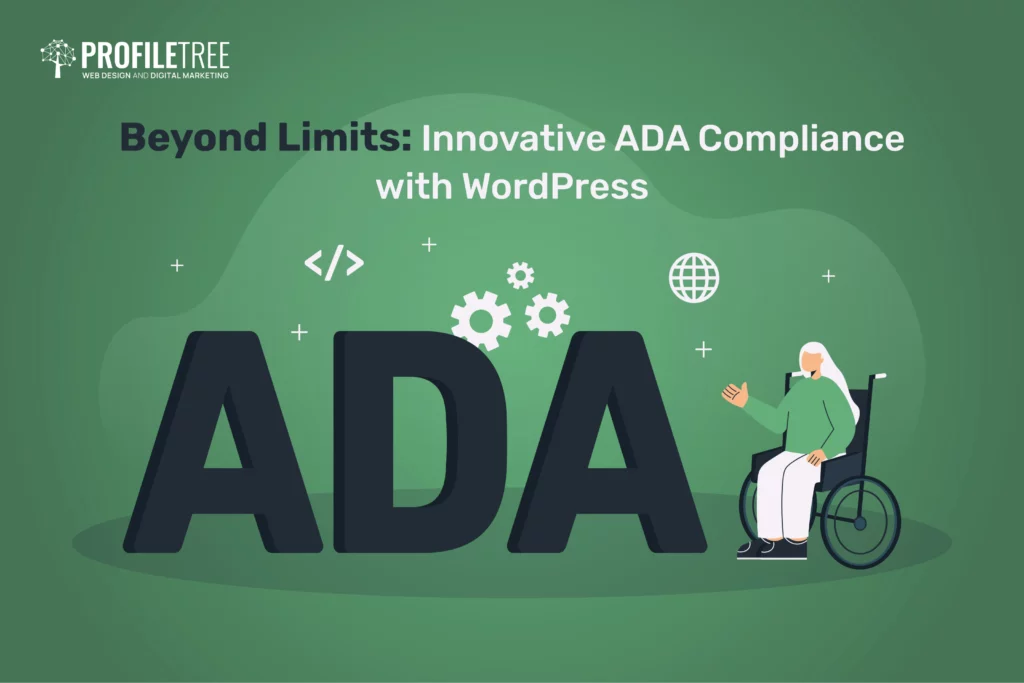In today’s digital age, websites serve as essential gateways for businesses and organisations to connect with their audience. However, ensuring that these online platforms are accessible to all users, including those with disabilities, is paramount. The Americans with Disabilities Act, commonly known as ADA, requires that websites adhere to specific guidelines to ensure equal access to disabled people.
Thankfully, WordPress, a widely used content management system (CMS), offers various features and plugins to facilitate ADA compliance. The ADA is a civil rights law that bans discrimination against disabled individuals in all aspects of public life, including websites and digital content. ADA compliance ensures that these platforms are accessible to people with disabilities who depend on assistive technologies to navigate the web.
Adhering to ADA compliance is not just a legal obligation; it’s also a matter of social responsibility and ethical business practices. ADA-compliant websites provide equal opportunities for all users, fostering an inclusive and welcoming online environment. WordPress websites can achieve ADA compliance by implementing a combination of built-in accessibility features and dedicated plugins.
The Definition of ADA Compliance and Its Significance

The Americans with Disabilities Act (ADA) discusses this disparity by mandating equal access to digital content and services for individuals with disabilities. ADA compliance, therefore, stands as a cornerstone of inclusive digital equity.
ADA compliance ensures that websites, software applications, and online services are designed and developed to allow disabled people to perceive, understand, navigate, interact, and contribute to them. This encompasses a wide range of accessibility considerations, including:
- Adding alternative text for images.
- Using clear and concise language.
- Employing keyboard navigation options.
Compliance with the ADA is not merely a legal obligation but a moral imperative reflecting the values of an inclusive and equitable society. Adhering to ADA guidelines allows businesses, government entities, and organisations to demonstrate their commitment to creating a digital world where everyone can thrive.
Moreover, ADA compliance can foster innovation and creativity as developers strive to design solutions that address the needs of a diverse user base. The scope of ADA compliance extends to all businesses and government entities in the United States that operate websites, create software, or provide online services. This includes e-commerce platforms, educational institutions, media outlets, and financial institutions. Failure to comply with ADA regulations can result in legal consequences, including lawsuits and fines. However, the actual cost of non-compliance lies in the exclusion and marginalisation of individuals with disabilities.
What are the ADA Requirements for Websites and Digital Content?
While the ADA doesn’t mandate a rigid set of technical specifications for websites and digital content, it prescribes a comprehensive framework of guidelines to ensure accessibility. These guidelines, encompassing a range of considerations, empower individuals with disabilities to navigate and interact with digital platforms seamlessly.
By providing alternative text descriptions for images, utilising headings and labels to structure content, ensuring form accessibility, enabling font size and colour adjustments, and furnishing transcripts for audio and video content, organisations can effectively bridge the digital divide and foster an inclusive online environment for all.
How to Comply with the ADA?
The first step towards ADA compliance is to conduct a thorough accessibility assessment of your website or digital content. This comprehensive evaluation should scrutinise various aspects, including alternative text for images, keyboard navigation compatibility, screen reader compatibility, and colour contrast adherence. By identifying any potential accessibility barriers, you can prioritise remediation efforts.
Upon identifying accessibility gaps, organisations must swiftly implement the necessary changes to their websites or digital content. This may involve adding alternative text descriptions to images, ensuring compatibility with assistive technologies, and adopting inclusive design principles. Addressing these accessibility barriers will remove obstacles and open doors for disabled individuals.
A crucial component of ADA compliance is establishing a responsive and effective process for addressing accessibility complaints. Organisations should designate a point of contact, such as an accessibility coordinator, to promptly handle any accessibility concerns users raise. By actively listening to feedback and taking prompt action, organisations can continuously enhance their digital accessibility posture.
Resources for ADA Compliance
There are three invaluable resources for ADA compliance that businesses and government entities can chart their course towards. As the official website of the U.S. Department of Justice Disability Rights Section, ADA.gov stands as a comprehensive repository of information on ADA compliance. From detailed legal guidance to practical tips and resources, ADA.gov empowers organisations to navigate the intricacies of ADA regulations confidently.
The Web Content Accessibility Guidelines, or WCAG, serve as the internationally recognised standard for web accessibility. These guidelines provide a structured framework for creating accessible websites for people with disabilities, encompassing various considerations, from alternative text for images to keyboard navigation compatibility.
Section 508 of the U.S. Rehabilitation Act establishes accessibility standards for electronic and information technology procured by federal agencies. These standards, mirroring the WCAG principles, ensure that federally funded websites are accessible to people with disabilities.
Different Ways Businesses Can Benefit from ADA Compliance
ADA compliance extends far beyond legal adherence; it represents a strategic imperative that unlocks a myriad of benefits for businesses. Embracing inclusive practices can allow businesses to thrive in different ways. ADA compliance, therefore, stands as a cornerstone of sustainable business success, fostering a thriving and inclusive environment that welcomes and empowers all.
Expanding Market Reach: Tapping into the Untapped Potential of Inclusive Design

Connecting with a diverse audience is paramount to achieving sustainable growth and success. ADA compliance, far from being a mere legal obligation, unlocks the doors to a vast and often overlooked market – the over 41 million individuals with disabilities in the United States.
Enhancing Customer Satisfaction: Cultivating Loyalty Through Inclusive Digital Experiences
Customer satisfaction lies at the heart of any thriving business. ADA compliance not only ensures that websites and digital content are accessible to all but also cultivates a sense of inclusivity and responsiveness among customers with disabilities. Empowering these individuals to navigate their online platforms seamlessly can only let businesses foster positive experiences, leading to increased customer satisfaction and loyalty.
Boosting Sales: Leveraging Inclusive Practices for Revenue Growth
Studies have consistently demonstrated that ADA compliance can directly translate into enhanced sales revenue. Businesses expand their customer base by catering to the needs of individuals with disabilities, tapping into a neglected segment. This inclusive approach not only drives sales growth but also strengthens brand reputation and establishes a competitive edge.
Mitigating Negative Publicity: Shielding Brand Image from Potential Damage
It’s no secret that negative publicity can swiftly erode brand reputation and hinder business growth. While legal repercussions are a significant concern for non-compliant businesses, the potential for negative publicity should not be underestimated. Adhering to ADA standards is one way to safeguard your brand image from potential damage. It’s also a great way to protect their reputation and foster long-term success.
Attracting and Retaining Top Talent: Fostering a Culture of Diversity and Inclusion
In the competitive pursuit of top talent, ADA compliance serves as a beacon of diversity and inclusion, attracting highly skilled individuals who align with values of equal opportunities and ethical practices. Businesses demonstrate their commitment to creating an inclusive workplace, empowering employees with disabilities to reach their ultimate potential and add to the company’s success.
Inspiring Employee Morale: Cultivating a Sense of Pride and Shared Values
Employee morale stands as a cornerstone of organisational success. Employees do their best when they feel valued, respected, and aligned with the company’s principles. ADA compliance fosters a sense of employee pride, knowing that the company is committed to creating an inclusive environment for all. This positive sentiment directly translates into enhanced morale, driving innovation and organisational success.
Strengthening Brand Reputation: Establishing a Legacy of Social Responsibility
In an increasingly conscious consumer market, brand reputation plays a pivotal role in shaping consumer choices. Businesses that champion ADA compliance are recognised as socially responsible entities, prioritising ethical practices and inclusivity. This positive brand perception attracts loyal customers and establishes a legacy of social responsibility, cementing the company’s position as a trusted and respected leader in its industry.
Can WordPress Websites Be ADA Compliant?
The great news is that WordPress websites can be ADA-compliant by following specific guidelines and using dedicated plugins. This website CMS provides various built-in accessibility features to make your website usable for everyone.
Here are some steps you should take to ensure your WordPress website is ADA-compliant:
Understand the Web Content Accessibility Guidelines (WCAG)
The WCAG is an international standard for website accessibility, outlining how to make content more accessible to people with disabilities. Familiarise yourself with the guidelines to understand the specific requirements.
Use a Design for Accessibility
Opt for an accessibility-focused theme when selecting one for your WordPress website. Ensure that the theme you choose adheres to WCAG standards and places a priority on accessibility. Verify whether the theme incorporates functionalities such as keyboard navigation, colour contrast, and alternative text for images.
Install an Accessibility Plugin
WordPress offers several accessibility plugins that can automate and enhance your website’s compliance efforts. These plugins can check for accessibility issues, provide alternative content, and improve overall usability.
Ensure Images Have Alt Text
Alternative text, or alt text or alt tags, is essential to web accessibility. The alt text should be concise and descriptive, providing enough information to convey the content and context of the image. It’s important to strike a balance between providing enough detail and keeping the alt text concise and to the point.
Create Accessible Forms
Create forms that facilitate smooth navigation and usability for both mouse and keyboard users. Ensure that form fields are clearly labelled, error messages are provided, and complex CAPTCHAs are avoided. When incorporating videos and audio content, make them accessible by providing transcripts or closed captions. This ensures that people with hearing problems can effectively access and engage with multimedia content.
Test Your Website Regularly
When it comes to ensuring the accessibility of your website, testing is a crucial step. Several tools and techniques are available to assist you in thoroughly assessing your website for compliance issues. Modern web browsers often include built-in accessibility tools to help you evaluate your website’s accessibility. As mentioned already popular platforms like WordPress have a wide range of plugins to facilitate ADA compliance, hence it is easier than ever to ensure compliance. These tools may provide insights into colour contrast, heading structure, and keyboard navigation and much more.
Seek Professional Assistance If Needed
It is advisable to seek guidance from an accessibility expert or a web development agency specialising in ADA compliance to ensure your website meets all requirements. Consulting with professionals in this field can provide valuable insights and assistance in making your website accessible and inclusive.
ADA compliance is essential to ensure everyone has equal access to the digital world. You can build an inclusive WordPress website that is accessible to all users by following these steps and staying up-to-date with accessibility guidelines to create a world where everyone has the opportunity to reap the benefits of the digital age.


